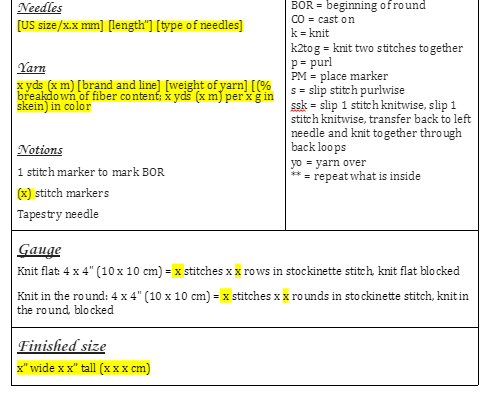
Use a template to design knitting patterns
I'm all for systems and processes that will make life easier, so I try to make templates for just about everything. When I get a request from a new designer to tech edit their pattern, typically my response is a templated response I have saved in Gmail, with some minor alterations. I have my invoices saved as a template in PayPal too so that I don't have to put my business info and rate in every time I create a new invoice. The list goes on. Templates just make life so much easier.
And you can do this to your patterns too. You may be asking: what is the difference between a template and a style sheet? How I see it is a style sheet is a document with every possible note you may need to use when designing future patterns and making sure everything conforms to your style. A template is basically an empty version of my pattern that I can fill in with details.
What to include on your pattern sales page
You may know that I hosted the Scrappy Project MAL a few months ago to encourage myself and others to knit from our stashes. It's good for the environment and your wallet, and you can create something out of yarns you never would have thought to pair together.
As I was looking for patterns to knit, I spent time on a lot of pattern pages on Ravelry and it got me thinking about what I like to see on that page as a knitter when I’m browsing. When I was shopping for a pattern, there were specific things I needed to know, and if that info wasn't there, I'd just move on.
So what should designers include?
Why the conversion rate from inches to cm is different in the knitting world than the real world
Typically when you need to convert inches to cm, you can just multiply the number of inches by 2.54 because that is the number of centimeters in a single inch. But if you follow this standard math rule in your knitting patterns, it’ll lead to some trouble.
In knitting, we need to use a conversion rate of 2.5 instead in order to get the right numbers. Why is this? Well, think of how gauge is listed on a pattern. Gauge is most often given in a 4 x 4″ or 10 x 10 cm square. But actually if you were to convert those 4 inches to cm using the 2.54 rate, you’d end up with a gauge swatch that is 10.16 x 10.16 cm. Not exactly easy to count stitches/rows to the decimal like that. So rather than making knitters grab their magnifying glasses to measure how many stitches/rows are in 10.16 cm, we round down to an even 10, and then have to alter the conversion rate to match a ratio of 4:10, which is 2.5.

Free tech editing checklist to use before getting your pattern tech edited
When I’m tech editing, I’m always conscious of the fact that the longer I take to edit, the more it will cost the designer. More errors in a pattern means I’m going to have to spend more time writing notes, and that time does add up.
So before you send your pattern off to a tech editor, give it a look to make sure you’ve listed all the correct information, and that all the information a knitter needs is also there.
Here’s a list of things I consider to be important on a pattern. If these things are missing, I’ll make note of it. So including them before you send over your pattern helps cut down on the notes I make.